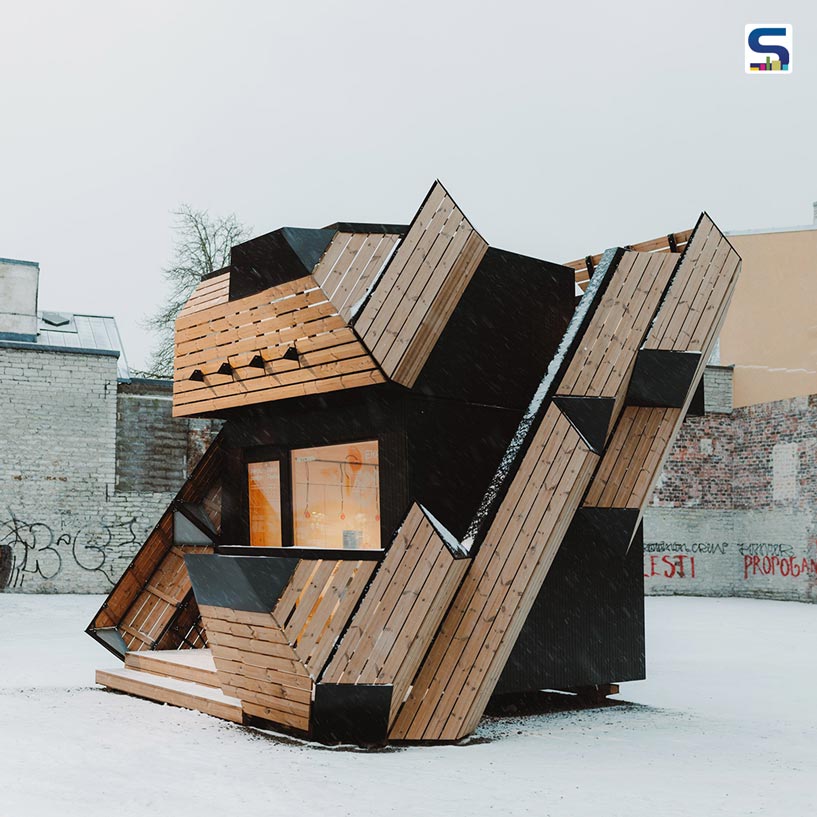
In the city of Tallinn, Estonia, an innovative experiment in sustainable construction is taking shape through the PAKK Pavilion, an angular timber structure designed to test and showcase a new type of insulation panel made from mycelium. The project represents a collaboration between materials company Myceen and the architecture department of the Estonian Academy of Arts (EKA), specifically its timber research centre, EKA PAKK. Together, they have created a structure that not only demonstrates cutting-edge materials but also reimagines construction systems for a sustainable future. Read more on SURFACES REPORTER (SR) as how waste products can be transformed into valuable resources.

The panels, referred to as mycocomposites, are created by allowing mycelium to grow and act as a natural binder for industrial residues such as sawdust and wood pulp.
From waste to wonder
The PAKK Pavilion serves as the first large-scale application of Myceen’s mycelium-based insulation panels, developed as an eco-friendly alternative to conventional options such as mineral wool or expanded polystyrene. Mycelium, the underground root network of fungi, has been attracting global attention for its ability to bind organic matter and form strong, lightweight composites. Myceen had previously worked with this biomaterial in the creation of pendant lampshades, but with the PAKK Pavilion, the company is now entering a new domain by using mycelium as a viable building product.
The panels, referred to as mycocomposites, are created by allowing mycelium to grow and act as a natural binder for industrial residues such as sawdust and wood pulp. Once the material achieves the desired structural quality, its growth is stopped through a specialised drying process. This results in insulation panels that are entirely natural, biodegradable and capable of replacing synthetic alternatives that often carry heavy environmental costs.

The pavilion’s distinctive angular form derives from the sLender facade system, which was initially designed as a response to the pressing issue of upgrading Estonia’s ageing housing stock.
Future of green construction
While Myceen focused on developing the panels, EKA PAKK took the lead in designing and building the pavilion itself. The structure integrates research from two of its ongoing projects, namely Pattern Building and sLender. Pattern Building is an open-source modular timber system that prioritises flexibility, enabling structures to be easily disassembled, altered or expanded depending on future needs. This principle guided the pavilion’s timber framework, which was constructed using ash dieback timber, which is wood salvaged from trees affected by disease but still structurally sound. The cubic frame was then clad in timber planks, ensuring both functionality and an elegant aesthetic.
The pavilion’s distinctive angular form derives from the sLender facade system, which was initially designed as a response to the pressing issue of upgrading Estonia’s ageing housing stock. The system’s lozenge-shaped, modular timber sections were conceived as over-cladding elements that could enhance existing buildings by providing insulation, balconies, or even modules for elevators and stairs. In the case of the PAKK Pavilion, these modules enclose a front terrace and incorporate a staircase that leads to a roof terrace, thus extending the usability of the compact structure.
At the heart of this experimental project lies the evaluation of Myceen’s insulation panels. The pavilion will serve as a live testing ground until the end of 2026, during which the panels’ thermal performance and resistance to mould will be monitored. Early findings are promising, where preliminary data indicated no risks of condensation or mould formation, thus showcasing the material’s excellent ability to manage moisture. According to Killu Leet, head of science at Myceen, the measured U-values suggested that the mycocomposite panels demonstrated better thermal resistance than mineral wool under identical conditions.

The pavilion will serve as a live testing ground until the end of 2026, during which the panels’ thermal performance and resistance to mould will be monitored.
Project details
Project executors: EKA PAKK and Myceen
Researchers: Dr Siim Tuksam, Dr Sille Pihlak and Dr Renee Puusepp
Period: 10.10.2024-09.10.2026
Funding: European Union and the Estonian Research Council through the project PUUSTER TEM-TA80, EKA development grant, Estonian Academy of Arts, Myceen
Image credit: Myceen and EKA PAKK